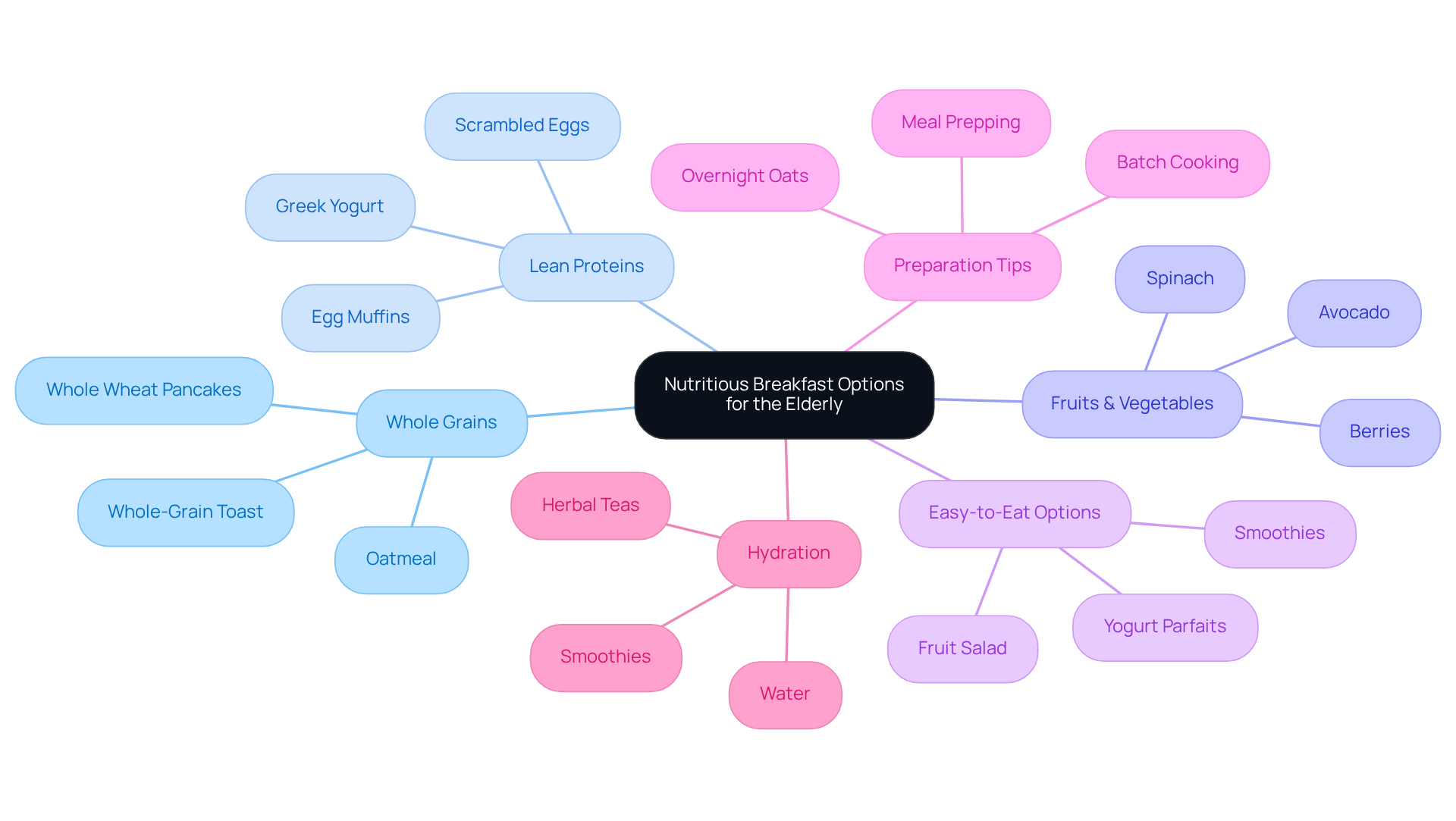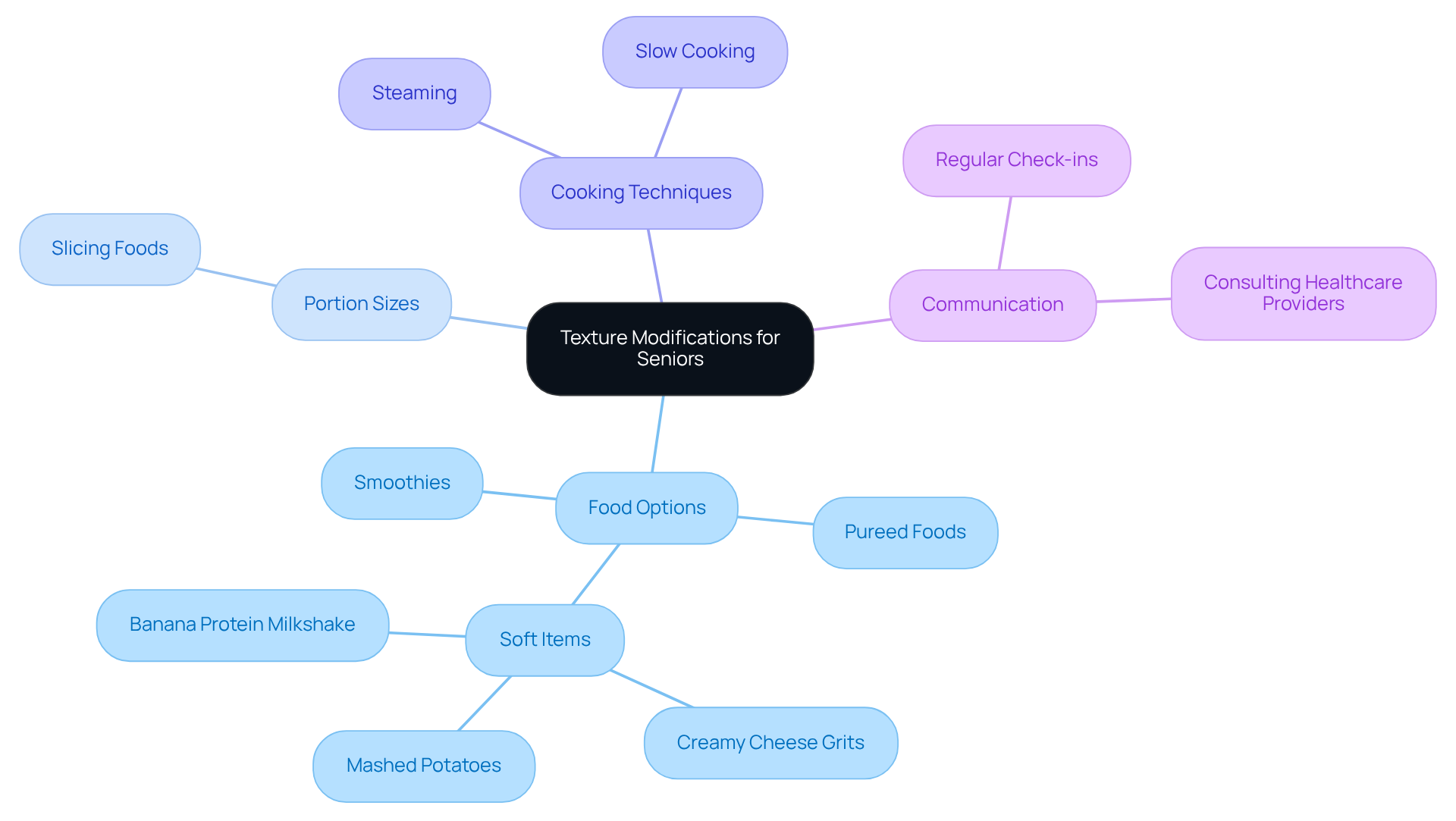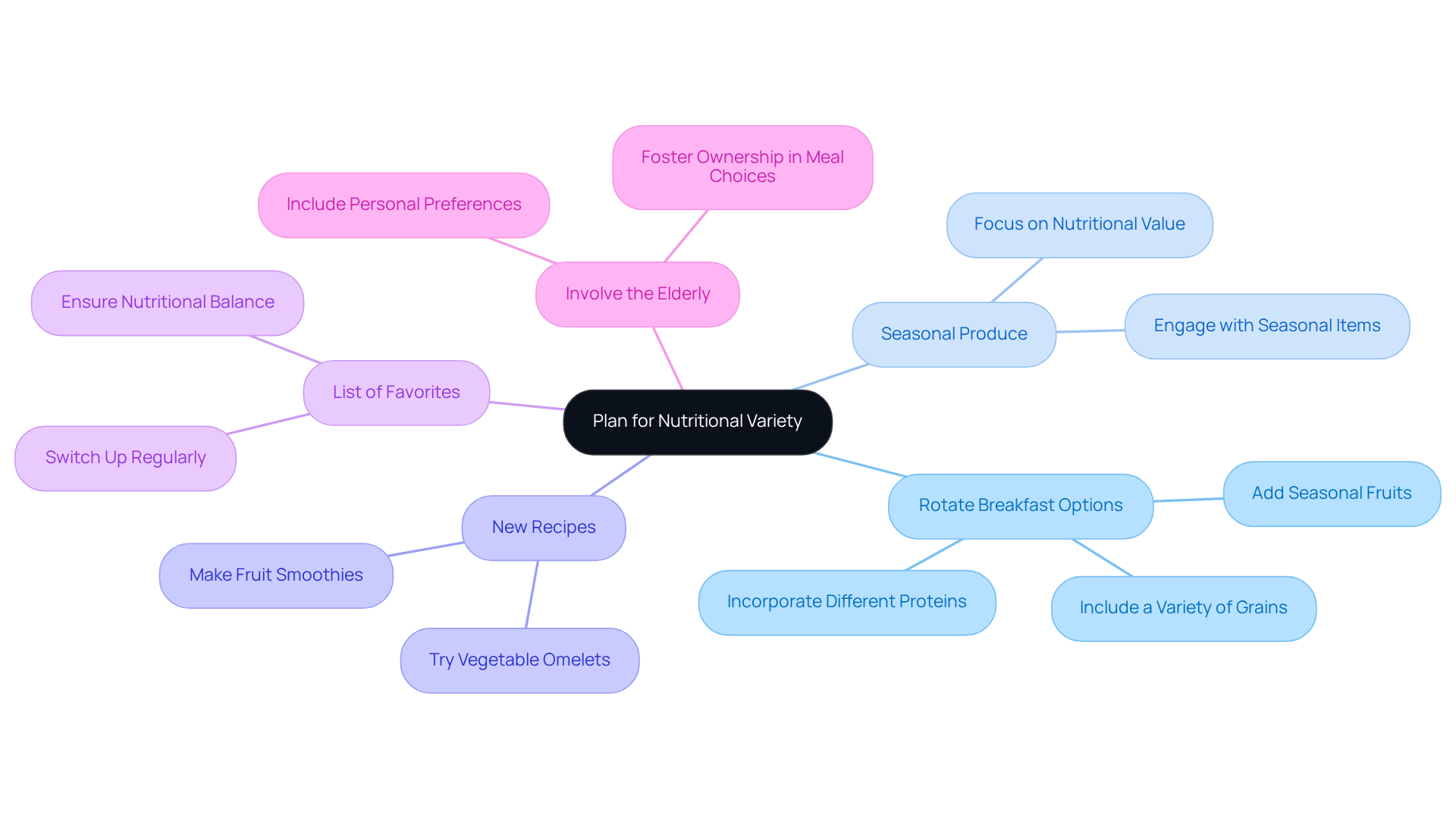Overview
Caring for elderly loved ones can be a rewarding yet challenging journey. As caregivers, you often face emotional hurdles, including stress and burnout, which can make even the simplest tasks feel overwhelming. That’s why it’s essential to focus on creating a healthy breakfast that not only meets nutritional needs but also brings joy to your mealtime experience.
Personalized meal planning is key. It’s important to consider individual dietary restrictions, preferences, and any medical conditions. By doing so, you can select nutritious options that cater to specific needs, ensuring that every meal is both beneficial and enjoyable. Think about incorporating texture modifications, as these can make a significant difference in how food is perceived and enjoyed.
Variety is another crucial element. Planning for nutritional diversity not only enhances health but also keeps mealtime exciting. Imagine the delight of presenting a colorful plate filled with different flavors and textures. It’s these small moments that can uplift spirits and foster connection during meals.
Remember, you’re not alone in this journey. Many caregivers share similar experiences, and there’s a wealth of support available. By focusing on nourishing both the body and the soul, you can create a mealtime experience that is not just about sustenance but also about love and care. Embrace the opportunity to make breakfast a cherished part of your day, filled with warmth and compassion.
Introduction
Understanding the nutritional needs of elderly individuals is essential for caregivers who want to offer not just sustenance, but a truly fulfilling dining experience. A thoughtfully planned breakfast can greatly enhance both physical health and emotional well-being. It’s a wonderful opportunity to cater to unique dietary preferences and restrictions.
Yet, with the complexities that come with age-related health issues, how can caregivers ensure that each meal is both nutritious and enjoyable? This checklist serves as a helpful guide to navigate these challenges. It empowers caregivers to create healthy breakfast options that genuinely nourish their loved ones, bringing comfort and joy to their dining experience.
Assess Nutritional Needs and Preferences
When caring for an elderly loved one, it’s essential to take the time to understand their unique eating preferences and any dietary restrictions they might have. A short interview can reveal valuable insights, helping you to connect with their needs on a deeper level.
It’s also important to consider any medical conditions that could influence their dietary choices, such as diabetes or hypertension. By customizing food options accordingly, you can help ensure they enjoy their meals, including a healthy breakfast for elderly.
Assessing their ability to chew and swallow is crucial, too. Some individuals may require softer food alternatives, which can make mealtime safer and more enjoyable.
Utilizing tools like the Mini-Nutritional Assessment (MNA) can be beneficial in evaluating their nutritional status. This helps identify any potential deficiencies that need addressing. Many older adults often struggle to get enough fiber from sources like whole grains, apples, raspberries, broccoli, and Brussels sprouts, so keeping an eye on this is vital.
Don’t forget about hydration! Ensuring adequate fluid intake is key, as dehydration can lead to complications like constipation, low blood pressure, dizziness, and headaches.
As you gather information about their preferences and restrictions, be sure to record everything carefully. This will guide future dining plans, ensuring that the dishes you prepare are both enjoyable and suitable for their needs.
It is important to regularly reassess nutritional needs to provide a healthy breakfast for elderly. Health conditions or personal preferences may evolve over time, so being flexible and ready to adjust dietary plans is essential.
Finally, consulting healthcare experts for dietary adjustments can provide peace of mind. They can help ensure that nutritional plans align with your loved one’s health requirements, allowing you to focus on what truly matters: their well-being.
Select Nutritious Breakfast Options
A healthy breakfast for elderly can serve as a wonderful opportunity to nourish both body and spirit. It’s important to include a variety of food groups in a healthy breakfast for elderly. Think about whole grains like oatmeal or whole-grain toast; they provide fiber and energy to kickstart the day. Lean proteins, such as eggs or Greek yogurt, are essential components of a healthy breakfast for elderly individuals to support muscle health. And don’t forget about fruits and vegetables—berries and spinach are packed with vitamins and minerals that are essential for a healthy breakfast for elderly.
For those who might have chewing difficulties, consider easy-to-eat options like smoothies or yogurt parfaits as part of a healthy breakfast for elderly. These options can be both nutritious and enjoyable, making a healthy breakfast for elderly a little easier. Preparing dishes in advance, such as overnight oats or egg muffins, can save precious time in the morning rush and help ensure a healthy breakfast for elderly, allowing for a more relaxed start to the day.
Experimenting with flavors and textures can keep meals interesting and enjoyable. It’s all about making breakfast a delightful experience. And let’s not overlook hydration; offering water, herbal teas, or smoothies alongside breakfast can help everyone feel refreshed and ready to take on the day.
Remember, you’re not alone in this journey. Many caregivers share similar challenges, and it’s okay to seek support. Together, we can create a nurturing environment that prioritizes health and well-being.
Incorporate Texture Modifications
Identifying individuals who may need texture adjustments is crucial, especially considering the challenges many seniors face with chewing and swallowing. Dysphagia can significantly impact their ability to enjoy standard meals safely, and it’s important to approach this with care and understanding.
For those experiencing considerable difficulties, offering pureed or soft items can make a world of difference. Think of smoothies, mashed potatoes, creamy cheese grits, and banana protein milkshakes. These options are not only easy to swallow but also packed with essential nutrients, ensuring that mealtime remains nourishing and enjoyable.
Slicing food into smaller, manageable portions can also help. This simple adjustment allows for easier consumption, making meals both safe and pleasurable. It’s all about creating a positive experience around food.
Utilizing culinary techniques that tenderize ingredients, like steaming or slow cooking, can enhance both the texture and taste of dishes. This makes meals more appealing to seniors, encouraging them to eat and enjoy their food.
Regular check-ins with individuals are vital. It’s important to ensure they feel comfortable with the food textures provided, as preferences can vary and change over time. Consulting healthcare providers for any concerns about an elderly person’s chewing or swallowing abilities is also recommended. This ongoing communication is essential for fostering a positive mealtime experience, allowing caregivers to provide the compassionate support that truly makes a difference.
Plan for Nutritional Variety
-
Rotate breakfast options weekly to include a variety of grains, proteins, and fruits. This not only ensures a balanced intake of nutrients but also keeps meals interesting. Research shows that incorporating a healthy breakfast for elderly individuals is linked to better health outcomes and can lower the risks of cognitive decline and frailty.
-
Introduce seasonal fruits and vegetables to keep dishes fresh and exciting. Seasonal produce often tastes better and packs more nutritional value, making it a wonderful choice for breakfast. Plus, engaging with what’s in season can help older adults find more affordable and nutritious options.
-
Encourage trying out new recipes that feature a mix of ingredients, like vegetable omelets or fruit smoothies. As Alana Biggers, M.D., points out, preparing meals can ease the stress of deciding what to eat each day and help older adults stick to their dietary budgets.
-
Keep a list of favorite dishes and switch them up regularly to ensure a good balance of nutrients and flavors. This approach helps manage nutritional diversity, which is so important for ensuring a healthy breakfast for elderly individuals and healthy aging.
-
Involve the elderly individual in meal planning to include their preferences. This fosters a sense of ownership and participation in their dietary choices, enhancing their overall satisfaction with meals.
Conclusion
Creating a healthy breakfast for elderly individuals goes beyond just providing food; it’s about truly understanding their unique nutritional needs and preferences. When caregivers prioritize these aspects, breakfast transforms into a nourishing and enjoyable experience that supports overall well-being.
Caregivers face emotional challenges, often feeling stressed and overwhelmed. It’s essential to assess individual dietary restrictions, select nutritious food options, and incorporate texture modifications for those with chewing and swallowing difficulties. Planning for nutritional variety is also crucial, keeping meals interesting and engaging. These strategies not only enhance meal quality but also contribute to better health outcomes for our seniors.
Fostering a nurturing environment around mealtimes can significantly impact the health and happiness of elderly individuals. Caregivers are encouraged to take a proactive approach, regularly reassessing nutritional needs and seeking support when necessary. By embracing these practices, caregivers can create a positive dining experience that prioritizes health, satisfaction, and connection. Each breakfast can become a meaningful start to the day, filled with warmth and care.
Frequently Asked Questions
Why is it important to assess the nutritional needs and preferences of elderly loved ones?
Assessing nutritional needs and preferences is essential to understand their unique eating habits, dietary restrictions, and any medical conditions that may influence their diet. This helps ensure they enjoy their meals and receive the necessary nutrients.
What tools can be used to evaluate the nutritional status of elderly individuals?
The Mini-Nutritional Assessment (MNA) is a useful tool for evaluating the nutritional status of elderly individuals. It helps identify any potential deficiencies that need addressing.
What dietary considerations should be made for elderly individuals with medical conditions?
Dietary considerations should include customizing food options based on medical conditions such as diabetes or hypertension, ensuring meals are suitable for their health needs.
How can chewing and swallowing abilities affect meal planning for the elderly?
Assessing their ability to chew and swallow is crucial, as some individuals may require softer food alternatives to make mealtime safer and more enjoyable.
What are some common nutritional deficiencies among older adults?
Many older adults often struggle to get enough fiber, which can be sourced from whole grains, apples, raspberries, broccoli, and Brussels sprouts. Monitoring fiber intake is vital.
Why is hydration important for elderly individuals?
Adequate fluid intake is key to preventing dehydration, which can lead to complications such as constipation, low blood pressure, dizziness, and headaches.
How often should nutritional needs be reassessed for elderly individuals?
Nutritional needs should be regularly reassessed, as health conditions or personal preferences may evolve over time, necessitating adjustments to dietary plans.
What role do healthcare experts play in dietary adjustments for the elderly?
Consulting healthcare experts can provide peace of mind and ensure that nutritional plans align with the elderly individual’s health requirements, focusing on their overall well-being.





